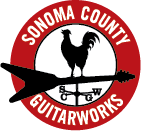In our last post, we had finished truing the cone well on this old resonator, and had it strung up for James to inspect. He decided he liked it, and went ahead with the work to make it playable. Here’s what we did – [singlepic id=1381 w=320 h=450 float=]
The neck was severely bowed and the brass frets were tiny and worn out. James decided that he liked the aesthetic of the brass, and he wanted to stick with the small size “mandolin” wire. He would be using the guitar for all types of playing, including fretted and slide, so the action needed to be comfortable, which meant sorting out the neck. To remove the bow, as the neck had no truss-rod, I first did a heat-press. This involves heating the neck, clamping it into a slight backbow then allowing it to cool. When it gets warm, the glue joint between the fingerboard and the neck shaft softens and slips, allowing the neck to move into a new, more correct shape. As it cools, the glue re-hardens and the neck stays where you put it. It’s a great technique, and I’ve used it to save many, many necks.
After the heat-press, I pulled the frets and loaded the guitar into the Plek, which created some severe visual tension. Something old, something new… The scan showed that the neck had straightened a good deal, but the fingerboard was still uneven and needed a good deal of wood removed to become true. Luckily the fingerboard and neck were both thick, so I planed it true and put it back on the bench. A cool thing about the Plek – the guitar had a slightly underset neck, so I was able to measure the thickness of the fingerboard, and then program the Plek to take an exact amount extra off the nut end of the fingerboard, creating a mini neck reset and helping to lower the action. You can’t save a really bad guitar this way, but it will make a big difference if you are already in the ballpark.
The fingerboard dots were all blown out, so I replaced those, dremeled the fret slots and readied the frets for installation. We chose to use Evo Gold mandolin wire to approximate the look of the brass frets, and the tang and barbs were a good deal thicker than the fret slots. I used the StewMac Fret Barber to trim the barbs down to the correct size for the slots, cut the individual frets to length and then hammered and glued them in. I usually use a pressing caul, but this board had a very slight radius, and careful hammering is not a problem if everything fits well. After beveling the fret ends, it was back to the Plek for the final fret dress. The scan showed that the fretwork was so good that it would have played fine without leveling, but I like things to be perfect, so I leveled and polished the frets. There was a bit of chip repair to do on the board, and then the final setup was very smooth.
[singlepic id=1385 w=320 h=240 float=]
James came in to play it and was floored by the transformation. There was a load of mojo inside this old junker just waiting to come out, it just needed someone to take notice, and James was just the guy. James was the first to see what was in this old guitar and now, when he plays it, everyone does.
[nggallery id=84]


